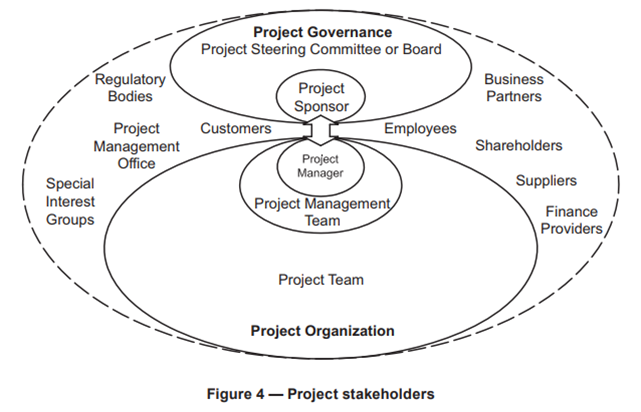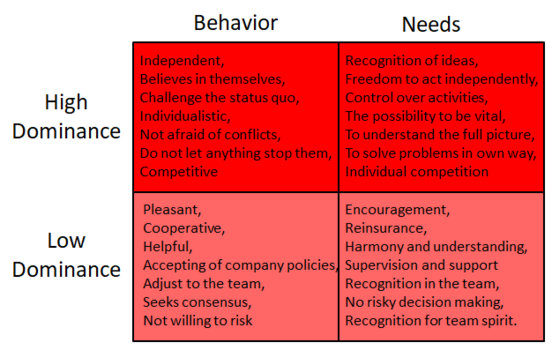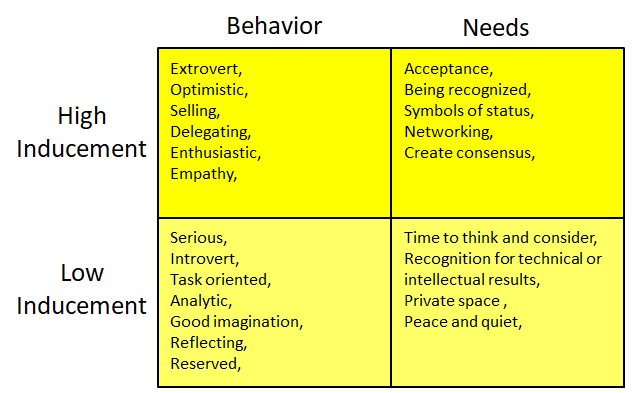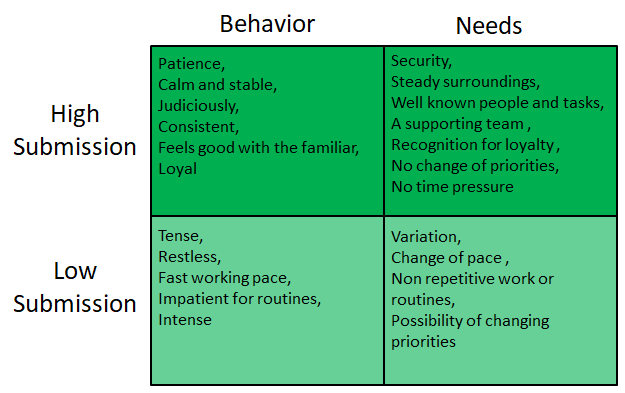Management with DISC profile analysis
(→Test Results) |
(→Dominance (D)) |
||
| Line 52: | Line 52: | ||
The behavioral trait of ''Dominance'' is characterized as seeing challenges and seeking to overcome them. People with a high D are characterized as confident, risk willing, determined, result oriented and demanding. They focus on shaping their surroundings to produce the outcome of the desired results. The people desires to have power and authority, take on challenges, get direct answers, have the liberty of no control and rules, make changes and new activities and the possibility of individual performance. The primary motive is taking control and be in charge and their major fear is losing control. They can be limited in lacking thoughts of others, being impatient, and lacking focus on quality. | The behavioral trait of ''Dominance'' is characterized as seeing challenges and seeking to overcome them. People with a high D are characterized as confident, risk willing, determined, result oriented and demanding. They focus on shaping their surroundings to produce the outcome of the desired results. The people desires to have power and authority, take on challenges, get direct answers, have the liberty of no control and rules, make changes and new activities and the possibility of individual performance. The primary motive is taking control and be in charge and their major fear is losing control. They can be limited in lacking thoughts of others, being impatient, and lacking focus on quality. | ||
| − | [[File:Dominance.png]] | + | [[File:Dominance.png|center|350x350px|frame|Characteristics of behavior and needs of a high and low ''Dominance'' profile.]] |
===Inducement (I)=== | ===Inducement (I)=== | ||
Revision as of 20:16, 27 February 2018
Contents |
Abstract
DISC (Dominance, Inducement, Submission, Compliance) analysis is a strategic tool for evaluating behavior often used internally in an organisation by managers to improve group dynamics and the well-being of the individual. DISC is a very simple and easy to use tool for improving relations, resolving conflicts, enhances motivation, and supports self-growth all by obtaining a better understanding of the individual’s personality. Misunderstandings happen daily and can lead to stress, unhappiness and low working effort. DISC was created by psychiatrist and professor William Moulton Marston, who believed all humans have psychological motives but they differ from human to human. The tool assesses the level of Dominance, Inducement, Submission, Compliance an individual possesses by referencing the norm.
[1].
Relevance & Application
The relevance and application of the tool can be extremely broad. Whereever and whenever human interations take place synergies or tensions unfold. DISC analysis can therefore be a tool for smoothing human relations. At work the tool can be used by all levels of managers and employees working on a project, program or portfolio basis. For example a management team who know each ohers DISC profiles can communicate better, shorten the time of their meetings, and prevent misunderstandings when they have the knowledge of the individuals behavioral profile. On the other hand a team manager can improve the wellbeing, communication and working effort of the team. Furthermore, it can provide the individual with personal insight giving rise for development.
Figure 1 illustates the complexity level of human interation between stakeholders invovled on a project basis. In theory the tool can be useful in all types of human relations but in practice it will be unlikely customers, suppliers and other non internal stakeholders are willing make provide their behavioral profile.
This article will be focussing on the usage of DISC behaviroal profile analysis as an operational tool for a project managers to improve the daily communication with the team.
Introduction
Background
The history of the four quadrants DISC personality profile can be traced all the way back to Empodocles four elements of fire, earth, air and water in 450 B.C. Empodocles observed people seemed to behave in four different ways due to external environmental factors. 50 years later Hippocrates redefined these as four internal factors called the four temperaments: choleric, sanguine, phlegmatic, and melancholic. Many years later the theory was advanced further by Carl Jung. In 1921 Jung reconfirmed personality traits were internal and attributed the differences to how people think. Jung saw these four differences as: thinking, feeling, sensation and intuition. Today these are often used in Myers Briggs Personality Test (MBTI).
The DISC personality was manifested in 1928 when William Moulton Marston published his book with the title “Emotions of Normal People”. The main principles of DICS have its roots in the book. Marston believed people’s daily behavior stems from their predictable characteristics. The behavior was not only seen as internal but also influenced by the external environment. Marston defined the personality trait as: Dominance, Influence, Steadiness and Compliance. Based on Marston’s theory Walter Clark developed the DISC personality profile in 1940 which is widely used today.
Method of use
Goals of Management with DISC
As a manager using the DISC profile analysis tool it should be sought to:
- Understand own behavioural traits and tendensies and develop an understanding of how own behaviour affect others.
- Understand, respect and value the individual differences on the team.
- Develop strategies to improve cooperation.
- Improve effectiveness in operations by advancing the relations with team members.
Practice
A DISC personality profile is created by answering a questionnaire about the person’s behavior in various situations. Every question has a rating scale such as “I strongly agree, agree, neutral, etc.”, which is answered according to matching the description of the person. The answers are subjective as the individuals are considered being experts on themselves.
The answers of the questions produces a profile report of the individual behavioral style, tendencies, needs, preferred environment and strategies useful for optimal behavior. Furthermore it also provides insights on the strength and weaknesses of the individual. The questions can for example ask in what way a person responds to challenges, influences others, working pace of comfortability and how rules and procedures are considered.
The DISC personality profile report evaluates the level of contribution of each of the four traits dominance, influence, steadiness and compliance. DISC can be considered as a “color palette of personality” where every person has their own unique blend. It is possible but highly unlikely to only have one of the four traits. Usually it is a combination for example a person can have dominance as the highest factor, influence as a secondary factor and steadiness as a third. The DISC personality profile shows how a person every day actions is affected, the preferences of various environments, the way of communication with others, response or avoidance to conflict.
This personality insight can be used by managers or team leaders in recruiting processes and provide them with a deeper knowledge of their team, group or colleagues. This knowledge is crucial for managers to support collaboration and communication. Proactive measures can be taken by managers to place people according to their preferences of environment to help them feel comfortable and empowered. When approaching people it can be done in a way that creates a positive response. It is widely believed in the community of psychologists that traits and situations are interactive. DISC can help managers adopting their responses based on the DICS profile of team members they are dealing with. This means managers should not always choose to use the behaviors that are the most comfortable for them, they should choose the behaviors that would be the most successful within the team.
Test Results
The DISC personality profile is strictly a measure of the individuals perception of themselves. All profiles are equally as good and it should not be considered as a test. The test results descripes some of the phsycological drivers which affects the behaviour.
The general rule: Different = Different and not Different = Wrong
In the following each of the four traits Dominance (D), Inducement (I), Submission (S) and Compliance (C) are considered. There exist different variations of the DISC letters such as Inducement/Influence, Submission/Steadiness, and Compliance/Conscientiousness. However, the overall interpretation is the same. [2] [3] [4]
Dominance (D)
The behavioral trait of Dominance is characterized as seeing challenges and seeking to overcome them. People with a high D are characterized as confident, risk willing, determined, result oriented and demanding. They focus on shaping their surroundings to produce the outcome of the desired results. The people desires to have power and authority, take on challenges, get direct answers, have the liberty of no control and rules, make changes and new activities and the possibility of individual performance. The primary motive is taking control and be in charge and their major fear is losing control. They can be limited in lacking thoughts of others, being impatient, and lacking focus on quality.
Inducement (I)
The trait of Inducement is perceived as extrovert and the aspiration of social interation with others. People with a high level of Inducement seek friendly and favorable environments where they can have an impact in collaboration with others. In addition, they will try to influence and convince others. They focus on creating results by convincing and including others in a team work. The characteristics are optimistic, creating confidence, emotional appealing, involving themselves in others, extrovert, enthusiastic, charming, and open. Furthermore, desires are to be popular, being the center of attention, being praised, group activities, having positive relations, and having the freedom of no control or details focus. The primary motive is to receive recognition from others and they fear social rejection. Their limitations are being impulsive, unorganised, over promising under delivering, and lacking of follow through.
Submission (S)
Profiles with a high Submission score seeks to conserve the surrounding working environment and keeping it stabile. They focus on solving tasks in collaboration with others. The characteristics are judiciously, reliable, collaboration oriented, patient and listing, loyal, caring for the group, and accepting. The desires are authentic appreciation, collaboration, using known methods and procedures in their work, stability, and time when nessesary to adapt to changes. The primary motive is stability and they fear changes and unexpected events. The limitations are putting others needs first and resistance against positive changes.
Compliance (C)
The triat of Compliance is considered the urge for formalities, rules and structure. The behavioral characteristics are seeking to work within established rules and guidelines to ensure high quality and aqurracy. People with a high level of Compliance focus on working under known conditions and to improve the quality of products and services. They are analytical and facts oriented and have awareness of standards and pay attention to details. Furthermore they are very consious, diplomatic, reliable and carefull, and can often be a bit reserved. The desires are being right, having complete overview, being praised for their tasks, limit risks, the possibility of leaning on authorities.
The primary motive is to ensure quality and aquarrcy and they fear mistakes, sloppy metholody, critism of their work and emotional situations. Limitations are very self critical, indeciceive, and lack of creativity.
Implementation of Results
When the manager believes to have the DISC theories underthe skin point 1) and 2) of the goals should come naturally. This section will therefore explore point 3) on how to develop strategies to improve cooperation. Questions to be asked are:
- How do the manager and the team members best communicate?
- How do the manager gain the trust of confidence of the team members?
- What concrete measures can the manager take in order to make the individual team members feel the most comfortable?
Assuming the manager already knows the DISC profile of the team members the task becomes What effective communication stategy can be utilized for the different DISC profiles. The following table provides an overview of how a manager should communicate with the team members of the four different behavioural profiles.
| Manager's Communication Strategy with Team Members DISC Profiles |
|---|
|
Dominance Profile
|
|
Inducement Profile
|
|
Submission Profile
|
|
Compliance Profile
|
When done aqurate the manager should be able to reach the goal 4) since team member relations are strengthen so the effectiveness in operations is increased.
Improve effectiveness in operations by advancing the relations with team members.
Benefits
The tool can be beneficial as a strategic tool on individual, team and organizational levels. It can be apllied on various needs of the company acspects of:
- Recruiting
- Individuel assesment
- Mangement development skills
- Talent spotting
- Optimization of teams and management groups
- Organizational development
- Change management
The questionaire is webbased and fast to anwer. It is provides consise, clear and simple profile analysis. It is a international tool and translated to many languages making it highly applicable for global companies.
Limitations
Behaviour is flexible, dynamic, and depends on situations.
It does not measure all aspects of the personality It is subjective. What you think of yourselves is not always the reality or how you are perceived by others.
Different variations from company to company. Overall still the same
- ↑ Marston, W. M., (1928), Emotions of Normal People, Kegan Paul Trench Trubner And Company
- ↑ www.discprofile.com
- ↑ www.discinsights.com
- ↑ www.peoplekeys.com




